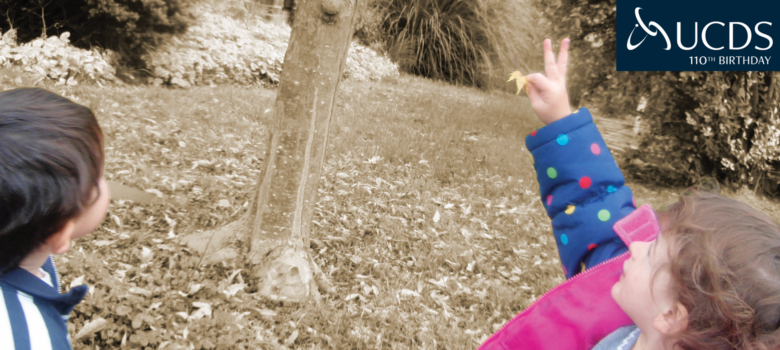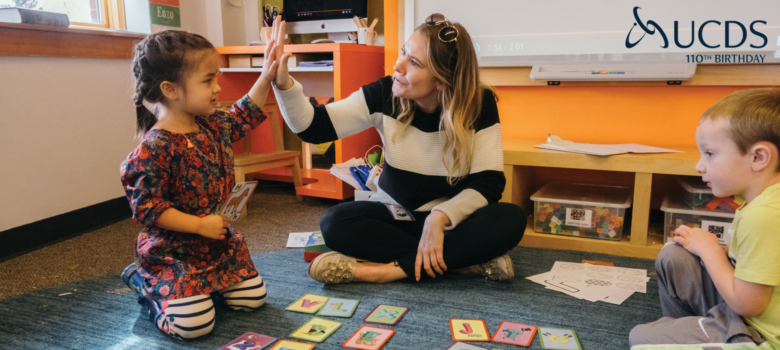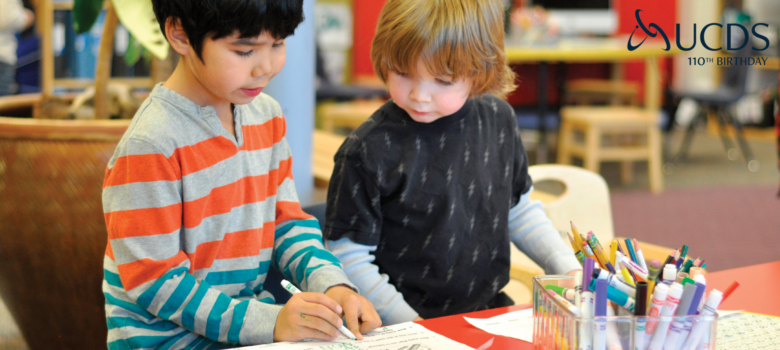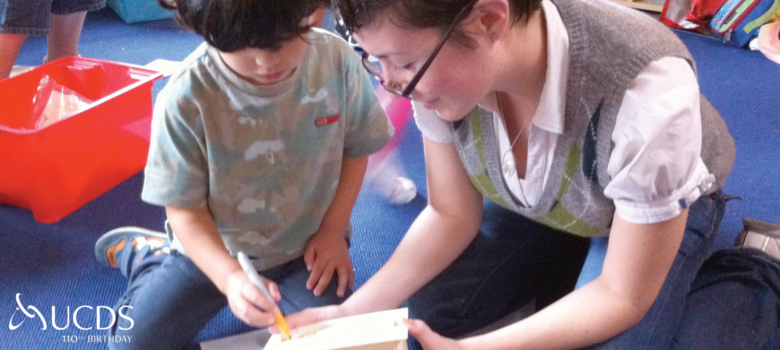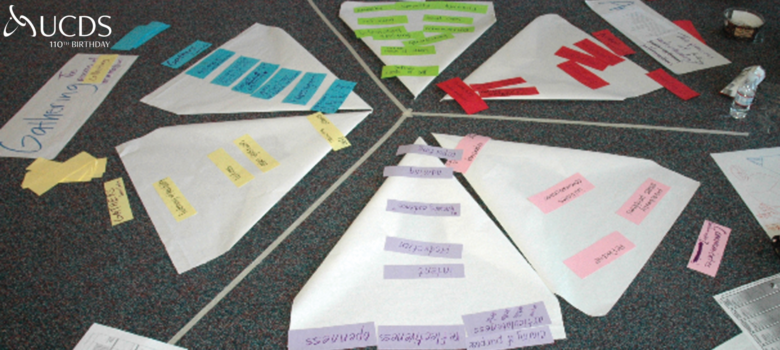UCDS is having a birthday! As we celebrate our 110th year, we are rolling back the clock and re-sharing six highlights of an innovative school: Culture of Inquiry, Sticky Curriculum, Authentic Assessment, Teacher Mentorship through Collaboration, Coaching Independence, and Being Brave. Over the next six weeks, we’ll revisit some in-depth reflections from UCDS Spark Magazine. You can also read full archived content of Spark Magazine at: https://issuu.com/ucds
The Search for the Elusive Gum Tree
by Sarah Andle
UCDS Spark
Issue #15, Fall 2015
“What is that?” exclaimed Matthew as he eagerly pointed to the pages of Lois Ehlert’s Leaf Man. Matthew and his friends crowded closer to their teacher as she held the book in the air. The teacher looked at the picture and read, “It’s a sweet gum fruit.” The eyes of the five children looking at her instantly lit up, followed quickly by questions of “Where is that?” and proclamations of “I want to find a gum tree!” She didn’t know it at the time, but this moment had just changed the course of their entire school year.
It was the beginning of the school year, and the Studio was exploring the fall changes in their neighborhood. After spotting a particularly large pinecone on a walk near a local college campus, the teacher gathered together five students to search around the Studio for more pinecone examples. Later, when reading Leaf Man, to build on the children’s interests about the changing seasons, Matthew asked the question – “What is that?” His three-words changed everything. The quest to find pinecones was quickly abandoned, and the search for the gum tree was on.
From the moment the Exploring Relationship and Connection (ERC) group that was focused on the gum tree set out on their first walk, the students were eager to find the elusive gum tree. They stopped at every tree to determine whether it may or may not be the gum tree. Even their teacher, who was as unfamiliar with a “sweet gum tree” as they were, carefully followed their lead and direction. They used some of the best tools they had available to them, their senses, to search and hunt for the elusive tree. They looked for the “spikey balls” that they had seen in Leaf Man and peered up through gorgeous fall colored leaves to look for signs of gumballs and gummy bears. Piles of leaves were excitedly searched through as the children literally immersed themselves in the trees. They scratched and sniffed bark hunting for the sweet smell of gummies and collected examples of what could possibly be evidence of a gum tree. They gathered pictures of data that could be used later as “study maps” to determine what a sweet gum tree may look like. While the group members never limited the scope of their search, whether it be for a magical tree full of gummy bears and fruit snacks or a tree full of spikey pinecone type balls, the five students made it clear that the tree they were looking for had not been found and the search needed to continue.
One morning, about a month into our search, Lily, a member of the gum tree group, came running into school with exciting news. While on a walk in her neighborhood with her family, she had a found a “spikey ball” lying on the ground! She and her mother collected examples and brought them in for the group to explore. When the time for ERC groups came, they excitedly gathered on the rug as the balls were passed around. This was the first time that they had something tangible from either the real or imagined gum tree to explore. They examined the balls in their hands, commenting on their texture and smell, and they quickly determined that they wanted to see what was inside. They made their way to the table as their teacher slowly cut open the first ball. Before it opened, the teacher asked the students what they thought they might see inside. “A bird!” Lily exclaimed! “My mom!” said Matthew. “A ball!” called George. Lily pushed back from the table and commented that she felt nervous to see what was inside. As the ball slowly opened, the students leaned into to take a peek. They commented on the smell, how it reminded them of pine trees and mint, and that this could be evidence that the spikey balls may in fact be related to the minty chewing gum they had noticed adults chewing. They continued to open several other balls, carefully examining each one. The students gathered supplies to help them explore, including magnifying glasses to get a closer look and play dough tools to help them cut the balls themselves. The children commented on what the spiky balls reminded them of. “It looks like a sea anemone!” shouted Oliver. “I think it looks like a fruit,” said Matthew. As George examined the spikey ball he proclaimed that he did in fact see a bird inside. They all gathered closer to see if they could get a better look. Lily suggested, “It’s a tiny bird. You need three magnifying glasses to see it.” The small round ball reminded Oliver of a microphone as he held it to his mouth and started singing a song. All of the children worked together to cut the sweet gum fruit into tiny pieces to share as a “snack” with their friends later. As they manipulated and explored the spikey balls, they continued to find connections and build relationships.
The following week, the group planned to go out on another search for the gum tree. The students had seen evidence of what a “sweet gum fruit” looked like, but there were still unknown possibilities for what direction their search might take them. As they gathered on the rug to prepare for the walk, Natalie exclaimed, “I know where to find gum!” She rushed away from the rug and returned shortly with her empty hand outstretched towards her teacher. “Here’s the gum!” she said. Lily looked skeptically at Natalie’s hand and declared, “There is nothing there!” Lily reached out to touch Natalie’s hand to prove it was empty, and Natalie warned, “Careful! They are fragile!” As Natalie passed her teacher her imaginary handful of gumballs, the children all crowded closer. The teacher offered each child a piece and each accepted. Lily watched as her other friends took a piece of gum. Her skepticism faded and was soon replaced with excitement as she joined her friends in the imaginary game. As they each chewed the make-believe gum, their teacher asked them what they thought it tasted like. Lily, Natalie, and Matthew all said their gum tasted like mint. Oliver described his as watermelon flavor. George had a huge smile on his face as he proclaimed his to taste like cheese! The pretend gumballs lasted for a few chews so the teacher offered to get out the peppermint flavored play dough to build off this interest in working with “gum.” She was interested to see if it inspired more gum conversations and creations. As they gathered around the table, each with their own ball of play dough, a discussion began about how they could make gum.
Lily: “How do we make it?”
Teacher: “How do you think we can?”
Matthew: “I know! We can mash it up and roll it up.”
Each person tried Matthew’s method.
Oliver: “Let’s make flapjacks!”
Lily: “I want to share my idea! We can make it into dough!”
They continued to work with the play dough in their hands.
Teacher: “Natalie, what’s your idea?”
Natalie: “You can make some holes in it and then roll it up and then cut it.”
The conversation and exploration with the play dough continued. Matthew’s gum could open and shut like the wheels of an airplane. George wanted to cut his ball into small pieces so that everyone could have a piece. Lily decided to make spaghetti gum. As they worked they continued to talk about the gum tree, the gumballs, and ideas about where they might find a gum tree themselves. The students had now been exposed to the “sweet gum fruit” they read about in Leaf Man. They had been given opportunities to share their own their ideas about what a gum tree may look like. They were at a crossroads in processing what a gum tree might be. Would it be full of gummy bears and gumballs? Or would it be covered in leaves and the “spikey balls” we had collected?
As the group processed what a gum tree might be, an unexpected encounter proved to be a pivotal moment in their journey. One day as Oliver, Natalie, and the teacher returned from the local library after returning some books, Natalie stopped dead in her tracks and enthusiastically yelled, “Look! Look! I see some gum!” Sure enough, right in front of them on the path was a “spikey ball.” She leaned forward to pick it up and smiled as she showed it to the others. Her teacher asked her where it came from, and she looked to the sky, pointed her finger and said, “Maybe it came from that one! See there’s more on that tree!” She paused as she processed what she had found. She exclaimed, “It is! THAT’S THE GUMTREE!” The joy and enthusiasm etched on her face were indescribable. Natalie collected examples from the tree, and hurried back to the Studio to tell her friends. As they returned to the classroom, the group began yelling, “Gum! Gum!” Matthew who was working at the table looked up as they entered.
Matthew: “What is your exciting news?”
Natalie handed him one of the gumballs that she had collected.
As Matthew took the gumball he gasped and a huge smile lit up his face.
Matthew: “A gumball!”
Teacher: “Where did it come from?”
Oliver: “The gum tree!”
Teacher: “We found the gum tree!”
Matthew: “Where?”
Teacher: “It’s right by the library, would you like to go see it tomorrow?”
Matthew: “Yes!”
George: “I want to go see it too!”
The day arrived when the entire ERC group would go and see the newly discovered gum tree. As the group set out on their journey Matthew began looking for clues on the ground. As they approached the library, the excitement continued to build. Natalie ran up to the tree she had seen before and said, “That’s the gum tree!” The group looked up and saw hundreds of spikey balls hanging on the tree. The children looked at each other and smiled and quickly began collecting gumball samples. While they didn’t find any gummy bears or chewing gum, the students were still thrilled to have completed their long sought-after quest for a gum tree. Some wanted to climb it, and others asked if we could bring it back to school. In the end, they said goodbye to the gum tree for that day and headed back to school.
The Studio children still visit the gum tree often. They also continue to keep their eyes peeled for a gummy bear covered tree. They are building upon the connections, understanding and relationships they made during the searching phase of their long-term investigation as they are now making maps to guide their fellow classmates to the location of the gum tree. While the epic search has come to an end, the kids’ desire to continue learning about the gum tree, make new connections, and share what they have learned with others continues to inspire conversations and collaborations throughout the Studio program.
The Studio teachers observed through this experience that when they followed the kids’ lead, honored their interests and allowed that to guide their next steps, an epic opportunity to make connections, build relationships and conduct research with their students emerged.

